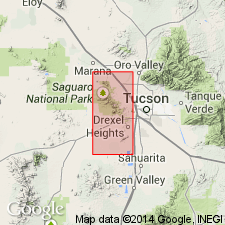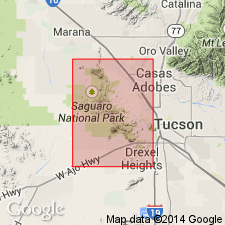
- Usage in publication:
-
- Rillito andesite
- Modifications:
-
- Original reference
- Dominant lithology:
-
- Andesite
- AAPG geologic province:
-
- Basin-and-Range province
Summary:
p. 736, fig. 2, pl. 1. Rillito andesite. On fresh surfaces, red to brown and contains numerous prominent feldspar crystals, most about 0.5 cm in length. Weathers drab to brown. Dense and breaks into angular blocks which retain their angularity and smoothness until a late stage of weathering. Maintains smooth surfaces on weathered outcrops. Thickness 450 feet west of Safford Peak. Underlies Safford tuff (new). Separated from underlying Cretaceous volcanics by poorly exposed conglomerate. Age is Tertiary.
A prominent cliff-former extending from cliffs west of Safford Peak to Silver Bell Pass, near north end of Tucson Mountain Range, Pima Co., southeastern AZ. [Origin of name not stated, but probably named from Rillito at north end of Tucson Mountain Range, in sec. 6, T. 12 S., R. 12 E., Marana 7.5-min quadrangle, Pima Co., southeastern AZ].
Source: US geologic names lexicon (USGS Bull. 1200, p. 3276).

- Usage in publication:
-
- Rillito andesite†
- Modifications:
-
- Abandoned
Summary:
Abandoned in Tucson Mountains, Pima Co, AZ, Basin-and-Range province. Replaced by Safford Dacite (revised) which includes units previously referred to as Rillito, Safford formation, Safford tuff, upper andesite, and Safford neck by Brown (1939) and Bikerman, Damon (1966, GSA Bull., v. 77, p. 1225-1234). [Author uses original spelling of "Rillito andesite" and other units of Brown (1939).] Safford is a cogenetic assemblage of dacitic to low-silica rhyolitic volcanic and volcaniclastic rocks that are remnants of a small volcanic field in northern part of Tucson Mountains. Because units of previous usage have small areal extent and are compositionally and genetically related, the unit names are discarded.
Source: GNU records (USGS DDS-6; Denver GNULEX).
For more information, please contact Nancy Stamm, Geologic Names Committee Secretary.
Asterisk (*) indicates published by U.S. Geological Survey authors.
"No current usage" (†) implies that a name has been abandoned or has fallen into disuse. Former usage and, if known, replacement name given in parentheses ( ).
Slash (/) indicates name conflicts with nomenclatural guidelines (CSN, 1933; ACSN, 1961, 1970; NACSN, 1983, 2005, 2021). May be explained within brackets ([ ]).

